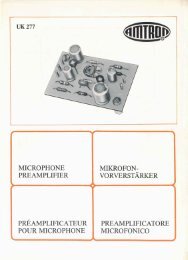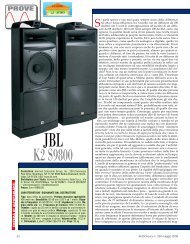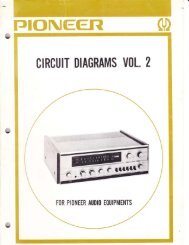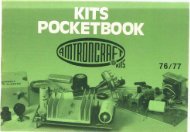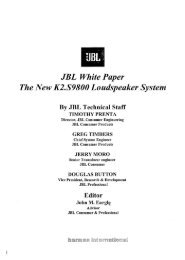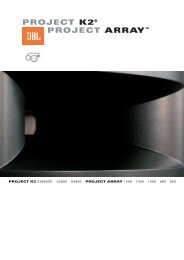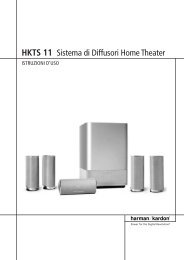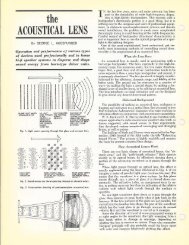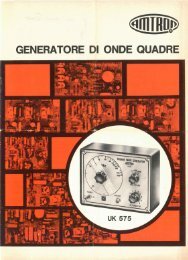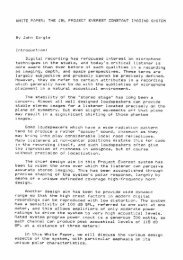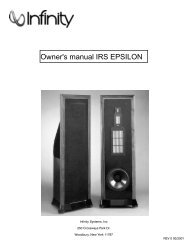JBL - New Lows in Home-Built Subwoofers (1983).pdf
JBL - New Lows in Home-Built Subwoofers (1983).pdf
JBL - New Lows in Home-Built Subwoofers (1983).pdf
You also want an ePaper? Increase the reach of your titles
YUMPU automatically turns print PDFs into web optimized ePapers that Google loves.
safe excursion limit of 1 <strong>in</strong>ch, peak-topeak.<br />
Extended bass at reasonable efficiency<br />
requires either very large box<br />
volume, or large amounts of amplifier<br />
horsepower—or both. We sat down<br />
with our friendly vented-box design<strong>in</strong>g<br />
computer and came away with two <strong>in</strong>terest<strong>in</strong>g<br />
candidates. The first is a 12-<br />
cubic-foot box tuned to 20 Hz. This is a<br />
classic sixth-order alignment requir<strong>in</strong>g<br />
6 dB of boost at 20 Hz and result<strong>in</strong>g <strong>in</strong><br />
a system f 3 (3 dB-down po<strong>in</strong>t) of about<br />
21 Hz. The second contestant is an 8-<br />
cubic-foot box, quasi-third-order alignment,<br />
tuned to 26 Hz. With 6 dB of<br />
boost added at 26 Hz, it becomes a<br />
quasi-fifth-order system with an f 3 of 26<br />
Hz. For this project, we chose the latter<br />
system because of its more moderate<br />
size. The 26-Hz cutoff was deemed low<br />
enough not to compromise sonic performance.<br />
Fig. 4—The <strong>JBL</strong><br />
Model BX63<br />
divid<strong>in</strong>g/summ<strong>in</strong>g network.<br />
PS- 2B.0 HZ VAS- 821.2 LITERS, 29.BO CU FT OTS- 0.270<br />
VB LITERS - 226.5 CU FT e.00 FB HZ 26.0<br />
Our computer provided a table, <strong>in</strong>cluded<br />
here, list<strong>in</strong>g driver parameters<br />
and response of the 2245H, and maximum<br />
output with respect to thermal<br />
and displacement limits when <strong>in</strong>stalled<br />
<strong>in</strong> the project box. Note the extremely<br />
high output levels. This system is the<br />
acoustical equivalent of the <strong>JBL</strong> Model<br />
B460 low-frequency loudspeaker.<br />
You might now ask, "Why equalize?"<br />
In order to keep the efficiency up and<br />
the box size down, we chose to take<br />
advantage of the driver's sizable power<br />
capacity and the relatively <strong>in</strong>expensive<br />
price of amplifier power. Notice<br />
that the system has an unequalized f 3<br />
of about 35 Hz, which means that the<br />
extra power demands of the boost only<br />
come <strong>in</strong>to play when there is substantial<br />
signal below 35 Hz.<br />
The equalization necessary to flatten<br />
the response is shown <strong>in</strong> Fig. 2. The<br />
2245H can be crossed over as high as<br />
500 Hz, because its midrange response<br />
is smooth. A number of lowlevel<br />
crossovers suitable for subwoofers<br />
are commercially available.<br />
Figure 3 shows the voltage drive of our<br />
recommended crossover, the <strong>JBL</strong><br />
Model BX63 (Fig. 4), which was chosen<br />
for this application because it was<br />
designed specifically for the present<br />
comb<strong>in</strong>ation of driver and enclosure.<br />
[Editor's Note: Plans for a crossover<br />
you can build yourself are elsewhere <strong>in</strong><br />
this issue.] Figure 5 illustrates the comb<strong>in</strong>ed<br />
subwoofer and crossover response<br />
with 3 dB-down po<strong>in</strong>ts of 26<br />
Fig. 5— Response of BX63 network<br />
(top curve) and driver's unassisted<br />
output (bottom curve) comb<strong>in</strong>e<br />
(middle curve) to produce flatter<br />
response down to 26 Hz and<br />
Fig. 6—Power compression of<br />
project subwoofer. Note lack of<br />
compression at levels below<br />
10 watts, slight compression above.<br />
greater output above 20 Hz than<br />
unassisted driver. Data above<br />
diagram are driver parameters for<br />
free-air resonance, compliance<br />
equivalent volume, and total "Q."<br />
Fig. 7— Distortion at 100 dB<br />
drive level. Levels shown for<br />
second- and third-harmonic<br />
products have been shifted up by<br />
20 dB to fit chart recorder.<br />
AUDIO/AUGUST <strong>1983</strong> 61



